Abstract
Tamarindus is a monotypic genus and belongs to the subfamily Caesalpinioideae of the family Leguminosae (Fabaceae), Tamarindus indica L., commonly known as Tamarind tree is one of the most important multipurpose tropical fruit tree species in the Indian subcontinent. Tamarind fruit was at first thought to be produced by an Indian palm, as the name Tamarind comes from a Persian word “Tamar-I-hind,” meaning date of India. Its name “Amlika” in Sanskrit indicates its ancient presence in the country. T.indica is used as traditional medicine in India, Africa, Pakistan, Bangladesh, Nigeria,and most of the tropical countries. It is used traditionally in abdominal pain, diarrhea and dysentery, helminthes infections, wound healing, malaria and fever, constipation, inflammation, cell cytotoxicity, gonorrhea, and eye diseases. It has numerous chemical values and is rich in phytochemicals, and hence the plant is reported to possess antidiabetic activity, antimicrobial activity, antivenomic activity, antioxidant activity, antimalarial activity, hepatoprotective activity, antiasthmatic activity, laxative activity, and anti-hyperlipidemic activity. Every part of the plant from root to leaf tips is useful for human needs. Thus the aim of the present review is to describe its morphology, and explore the phytochemical constituents, commercial utilization of the parts of the plant, and medicinal and pharmacologic activities so that T. indica's potential as multipurpose tree species can be understood.
Keywords: Antidiabetic, antioxidant, antimicrobial, antiinflammatory, hepatoprotective, Tamarindus indica
INTRODUCTION
Medicinal plants are the back bone of Traditional medicine.[1] Traditionally, the use of plant preparation as sources of drug are based on the experience and superstitions passed from generation to generation, virtually by the word of mouth.[2] Research on medicinal plant has increased recently all over the world. Medicinal plants have been used in various systems, as they have potential against numerous diseases. The movement of Tamarind to Asia must have taken place in the first millennium BC. Cultivation of Tamarind in Egypt by 400 BC has been documented and it was mentioned in the Indian Brahmasamhita Scriptures between 1200and 200 BC. About 370-287 BC, Theophrastus wrote on plants and two descriptions refer to Tamarind, his sources were probably from East Africa.
Taxonomical classification
Kingdom Plantae
Phylum Spermatophyte
Class Angiosperm
Sub class Dicotyledone
Family Leguminosae
Subfamily Caesalpiniaceae
Genus Tamarindus
Species indica
Plant description and morphology
Tamarindus indica [Figure 1] is of moderate to large in size, evergreen tree, up to 24 m in height and 7m in girth. The latest morphologic and molecular analyses and continued study will clarify the exact positioning of Tamarindus in relation to its putatively related genera.[3–7] It is a large evergreen tree with an exceptionally beautiful spreading crown, and is cultivated throughout almost the whole country, except in the Himalayas and western dry regions.[8] Leaves alternate, compound, with 10-18 pairs of opposite leaflets; leaflets narrowly oblong, 12-32×3-11 mm, petiole and rachis finely haired, midrib and net veining more or less conspicuous on both surface. Flowers attractive pale yellow or pinkish, in small, lax spikes about 2.5 cm in width. Flower buds completely enclosed by 2 bracteoles, which fall very early; sepals 4, petals 5, the upper 3 well developed, the lower 2 minute. Fruit is a pod, indehiscent, subcylindrical, 10-18 ×4 cm, straight or curved, velvety, rusty-brown; the shell of the pod is brittle and the seeds are embedded in a sticky edible pulp. Seeds are 3-10, approximately 1.6 cm long, irregularly shaped, and testa hard, shiny, and smooth.
Figure 1.
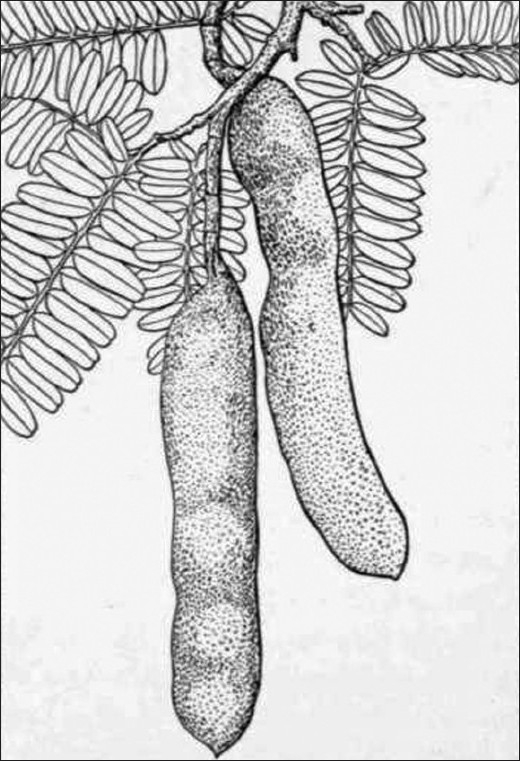
Tamarindus indica
Vernacular names
In India, Tamarind is known by a wide variety of vernacular names: Tetuli (Assamese); Amli, Nuli, Textili Tentul (Bengali); Amali, Ambali (Gujarati); Ambli, Amli, Imli, (Hindi); Puli (Malayalam); Amli, Chinch, Chitz (Marathi); Koya, Tentuli (Oriya); Imli (Punjabi); Chinta (Telugu).[9]
T. indica is used as a Traditional medicine in India, Sudan, Nigeria, Bangladesh, and most of the tropical countries. Contrary to pharmaceuticals, it is often freely and readily available.[10–16] Almost all parts of the tree find some use or the other in food, chemical, pharmaceutical, and textile industries, and as fodder, timber, and fuel.[17,18] Commercial plantations are reported in Central American countries and in north Brazil.[19] Large segments of human population and animals in the developing countries suffer from protein malnutrition. T. indica is rich in nutrients and plays an important role in human nutrition, mainly in the developing countries.[20,21] T. indica contains high levels of crude protein. T. indica also contains a high level of protein with many essential amino acids, which help to build strong and efficient muscles T. indica is also high in carbohydrate, which provides energy, and is rich in minerals, such potassium, phosphorus, calcium, and magnesium. T. indica can also provide smaller amounts of iron and vitamin A. The whole plant of Tamarind is uesd extensively for medicinal and industrial purpose, hence it is very beneficial to the human being.[22]
Chemical constituents of T. indica
Phytochemical investigation carried out on T. indica revealed the presence of many active constituents, such as phenolic compounds, cardiac glycosides,[23] L-(-)mallic acid,[14] tartaric acid, the mucilage and pectin, arabinose, xylose, galactose, glucose, and uronic acid.[24,25] The ethanolic extract of T. indica showed presence of fatty acids and various essential elements like arsenic, calcium, cadmium, copper, iron, sodium, manganese, magnesium, potassium, phosphorus, lead, and zinc.[26]
The pulp contains organic acids, such as tartaric acid, acetic acid, citric acid, formic acid, malic acid, and succinic acid; amino acids; invert sugar (25-30%); pectin; protein; fat; some pyrazines (trans-2-hexenal); and some thiazoles (2-ethylthiazole, 2-methylthiazole) as fragrant; and the seed polysaccharides are found with a main chain consisting of β-1,4-connected glucose molecules together with xylose (alpha-1,6) and galactose; total protein; lipids with fatty oils; and some keto acids.[27] In the leaves of the plant, two triterpenes, lupanone and lupeol [Figure 2] were found.[28]
Figure 2.
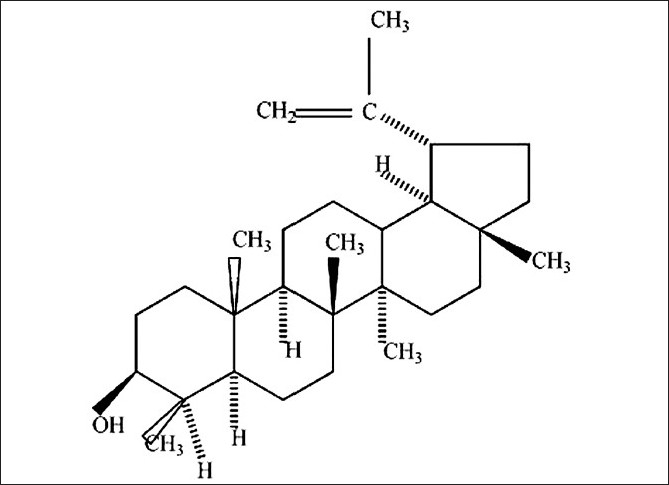
Lupeol
The leaf oil contains 13 components among which linonene and benzyl benzoate were most predominant.[29] Phytochemical investigation of the root bark of T. indica showed the presence of n-hexacosane, eicosanoic acid, b-sitosterol, octacosanyl ferulate, 21-oxobehenic acid, and (+)-pinitol. The presence of the bioactive compound (+)-pinitol in this plant is being reported for the first time.[30] The volatile constituents of the fruit pulp were furan derivatives (44.4%) and carboxylic acid (33.3%) of the total volatiles.[31] The major fatty acids of seeds were palmitic acid, oleic acid, linoleic acid, and eicosanoic acid. The unsaponifiable matter from the seed oil of T. indica showed presence of β-amyrin, compesterol, β-sitosterol and seven hydrocarbons.
The aerial parts of this plant have demonstrated the presence of tartaric acid, acetic acid, and succinic acid, gum, pectin, sugar, tannins, alkaloid, flavonoids, sesquiterpenes, and glycosides.[32–35] T. indica seeds and pericarp contain phenolic antioxidants.
The profile of polyphenolics in Tamarind pericarp was dominated by proanthocyanidins in various forms, such as apigenin [Figure 3], catechin [Figure 4], procyanidin B2, epicatechin [Figure 5], procyanidin dimer [Figure 6a], procyanidin trimer [Figure 6b], along with taxifolin [Figure 7], eriodictyol [Figure 8], naringenin [Figure 9], of total phenols, respectively. The content of Tamarind seeds comprised only procyanidins, represented mainly by oligomeric procyanidin tetramer, procyanidin hexamer, and procyanidin pentamer with lower amounts of procyanidin B2 epicatechin.[36]
Figure 3.
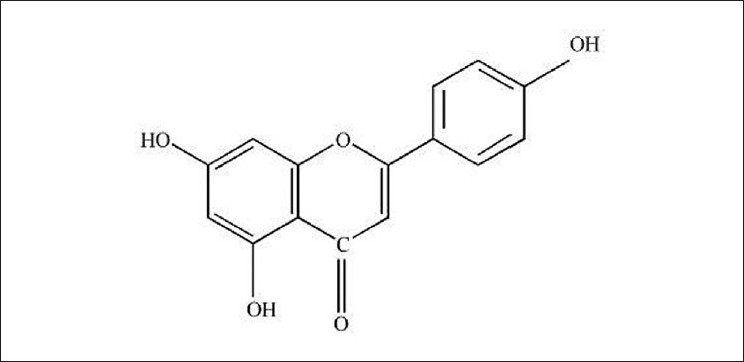
Apigenin
Figure 4.
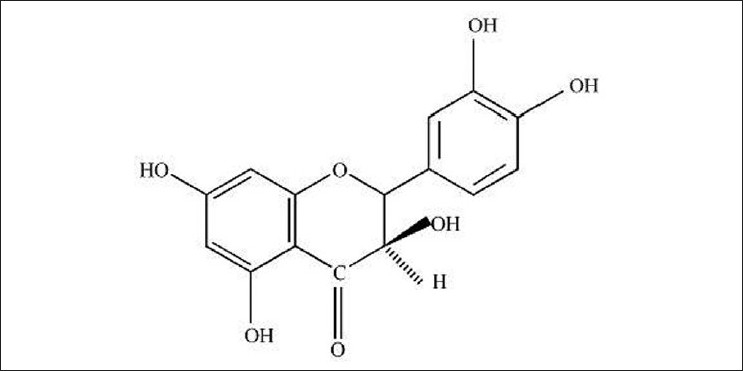
Catechin
Figure 5.
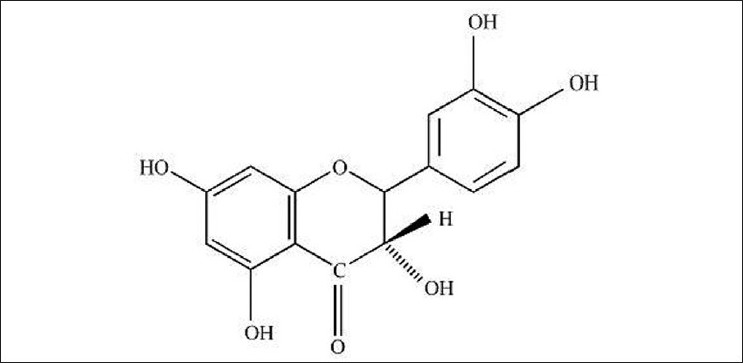
Epicatechin
Figure 6.

(a) Procyanidin dimer (b) Procyanidin trimer
Figure 7.
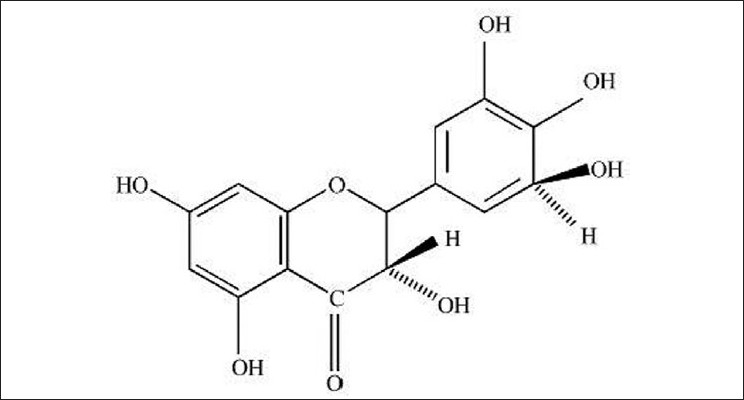
Taxifolin
Figure 8.
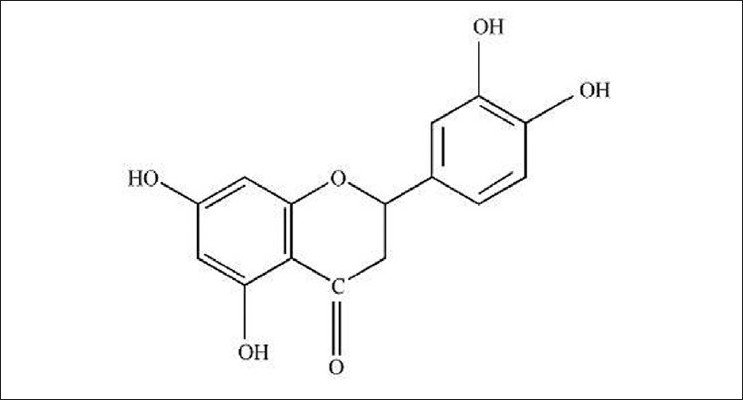
Eriodictin
Figure 9.
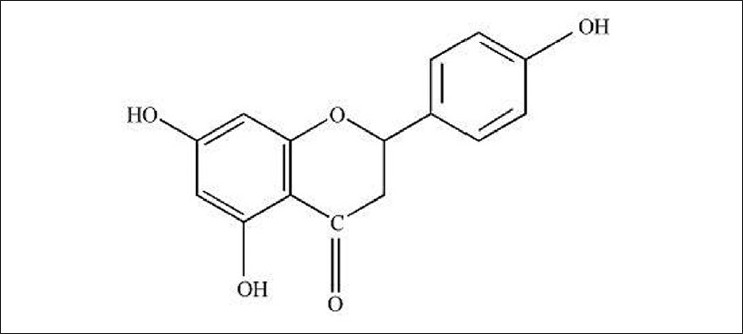
Naringenin
Uses of various parts of T. indica
Fruit pulp
Tamarind is valued mostly for its fruit, especially the pulp, which is used for a wide variety of domestic and industrial purposes.[37] The acidic pulp is used as a favorite ingredient in culinary preparations, such as curries, chutneys, sauces, ice cream, and sherbet in countries where the tree grows naturally,[38–40] In India, the pulp is also eaten raw and sweetened with sugar.[41] Tamarind pulp is also used to make sweet meats mixed with sugar called Tamarind balls.[42] Tamarind pulp is used as a raw material for the manufacture of several industrial products, such as Tamarind Juice Concentrate, Tamarind Pulp Powder, tartaric acid, pectin, tartarates, and alcohol.[43,44]
Seed
Tamarind seed is a by-product of the commercial utilization of the fruit, the seed comprises the seed coat or testa (20-30%) and the kernel or endosperm (70-75%).[45,46]However, it has several uses. It is commercially available as a food additive for improving the viscosity and texture of processed foods.[47] The name “jellose” has been suggested for the seed polysaccharide as it describes both its jelly forming properties and the carbohydrate character.[48,49] It has been recommended for use as a stabilizer in ice-cream, mayonnaise, and cheese and as an ingredient or agent in a number of pharmaceutical products, and the seed oil is said to be palatable and of culinary quality.[50] The oil is used for making varnish to paint idols,[51,52] and light lamps.[53,54]
Flowers and leaves
The leaves, flowers, and immature pods of Tamarind are also edible. The leaves and flowers are used to make curries, salads, stews, and soups in many countries, especially in times of scarcity.[55] These are used in some Thai food recipes because of their sourness and specific aroma.[45] Children in Gambia mix the acid leaves with gum from fig trees to make a chewing gum.[56] The leaves and flowers are also useful as a mordant in dyeing. A yellow dye derived from the leaves colors wool red and turns indigo dyed silk to green.[52,54] Mature leaves are used as a bleaching agent in the preparation of young leaves of “buri” (Corypha alata) for hat making in the Philippines.[57
Wood
Tamarind wood has many uses, including making furniture, wheels, mallets, rice pounders, mortars, pestles, ploughs, well construction, tent pegs, canoes, side planks for boats, cart shafts and axles, and naves of wheels, toys, oil presses, sugar presses, printing blocks, tools and tool handles, turnery, and so on.[58,59] In North America, Tamarind wood has been traded under the name of “Madeira mahogany”[60] It is valued for making gunpowder.[42,60,61] The ash is used to remove hair from animal hides.[38,54,62] and can be mixed with fruit pulp for cleansing and brightening brass and copper vessels.
Seed testa and bark
The seed testa contains 23% tannin, in leather tanning tests, Tamarind tannin gives harsh and highly colored leather, which could be used for heavy soles, suitcases, and others. The seed husk has also been found to be an effective fish poison.[63,64] Bark tannins are used in the preparation of ink and for fixing dyes.[65]
Tamarind kernel powder
Tamarind Kernel Powder (TKP) produced from the seeds is another commercial product and is often reported in commercial digests.[66] The TKP will become rancid and brown if stored inadequately and the storage ability and color will be better if it is defatted.[67] In India, TKP is used as a source of carbohydrate as the adhesive or binding agent in paper and textile sizing, and weaving and making jute products,[46,52] as well as textile printing.[68]
Medicinal and pharmacologic properties
Antimicrobial activity
T. indica has a broad spectrum of antibacterial activity. The methanolic leaf extract of T. indica was assessed for antibacterial activity against Burkholderia pseudomallei, and its name in vitro inhibitory potential suggests further animal studies to understand the role of T. indica in treating melioidosis.[69] Methanol and acetone extracts of T. indica have showed significant antimicrobial activity against Klebsiella pneumoniae the antibacterial activity was done by agar disk diffusion method. The activity was compared with standard antimicrobials Amikacin and Piperacillin.[70] The antimicrobial activity of the concentrated extracts (aqueous, ethonolic, acetone extract) were evaluated by determination of the diameter of zone of inhibition against both gram-negative and gram-positive bacteria and fungi using the paper disk diffusion method. These have potent antimicrobial activity against Salmonella paratyphi, Bacillus subtilis, Salmonella typhi, and Staphylococcus aureus.[71] Other studies have suggested that T. indica has shown potential antimicrobial activity; and that petroleum ether, water, ethanol extract of T. indica ripe fruit were evaluated for possible antibacterial activity against gram-positive and gram-negative species,[72] methonolic and aqueous extract of 30 medicinal plants and T. indica flower have shown anti-microbial activity.[73] The methanolic extracts of 14 species showed antibacterial activities during this preliminary screening. The result showed that the extract from T. indica possesses strong in vitro antibacterial activity against the bacteria tested.[74]
Antioxidant properties
The seed and pericarp of T. indica contain phenolic antioxidant compound.[36] Soxhlet methanolic extract of T. indica may be an important source of cancer chemopreventive. All extracts of T. indica exhibited good antioxidant activity (64.5–71.7%) against the linoleic acid emulsion system and the values were lower and higher than the synthetic antioxidant, butylated hydroxyl anisole and ascorbic acid.[75] Thai Tamarind seed coat using solvent extraction with ethanol was found to be the most active in terms of peroxide value.[76] Ethanolic extract of fruit pulp of T. indica showed significant antioxidant and hypolipidemic activity in hypercholesterolemic hamsters,[77] Antioxidant activity of ethanolic extract of seed coat of T. indica by DPPH (2,2-diphenyl-1-picrylhydrazyl) free radical scavenging method using ascorbic acid as a standard. This activity of T. indica extract may be attributed to its free radical-scavenging ability.[78] Ethanol extract prepared from the seed coat of T. indica exhibited antioxidant activity as measured by the thiocyanate and thiobarbituric method.[79] Ethyl acetate extracts prepared from the seed coat also had strong antioxidant activity. This was confirmed by some authors.[76] T. indica seed coat, a byproduct of the Tamarind gum industry, could be used as a safe and low-cost source of antioxidant, although other herbals may be more effective.[80]
Laxative properties
The fruit of T. indica is used traditionally as a laxative, due to the presence of high amounts of malic and tartaric acids and potassium acid.[62] Children in Madagascar are given whole Tamarind fruits for breakfast to overcome constipation. The laxative can be taken in the form of a sweetmeat, called Bengal by the Wolof people of Senegal, prepared from the unripe fruit of Tamarind and sometimes mixed with lime juice or honey.[38] In Bamako, Mali, drinks are prepared from the pulp[81] and in Burkina Faso, the fruits are crushed and soaked for half a day in water with a little salt before consumption.[82] Tamarind use as a laxative refers to the use of its fruit, and also the use of a macerate of its leaves with potash has been reported in northern Nigeria.[83]
Abdominal pain
Abdominal pain is not a specific disorder but a complaint, which refers to a painful abdomen and which may have a wide variety of causes, including constipation or diarrhea. Soaked fruits are also eaten by rural Fulani in Nigeria, to relieve constipation.[84] When T. indica leaves are used, it is more difficult to assess what may have caused the abdominal pain. In East Africa this could be due to diarrhea,[85–87] whereas in West Africa, although atypical, leaves have been known to be laxative[83] and macerated fresh bark of the young twigs was used both as a purgative and to relieve abdominal pain.[88] Roots, prepared as an extract, are used in the treatment of stomach ache or painful abdomen, mainly in East Africa,[87,89] and also in Burkina Faso it is used in abdominal pain and related complaints.[16] In Benin, the fresh bark of young stems is macerated for 24 h and taken orally as a purgative or for abdominal pain.[88]
Wound healing
T. indica is often cited in the literature concerning the treatment of cuts, wounds, and abscesses. T. indica, bark or leaves are most commonly used, is applied externally on the spot, either as a decoction or as a powder or poultice, alone or in combination with other species.[13,88,90,91] In the medicinal plant market in Dakar, Tamarind bark is mostly sold for wound healing purposes,[92] occasionally other Tamarind plant parts are found in wound healing medicine, such as the fruit,[93] the pod husks,[13] or the gum.[91] A decoction of T. indica leaves is one of the most important agents to clean wounds caused by Guinea worm infections.[94]
Malaria and fever
Fruits of Tamarind are known as a febrifuge in Madagascar;[95] in Ghana, malaria is treated with Tamarind leaves,[96] and the fruit pulp is used as a febrifuge and laxative.[13]
Antidiabetic activity
An aqueous extract from T. indica seeds had a potent antidiabetogenic activity in Streptozotocin-induced diabetic male rats. The aqueous extract of T. indica seeds was given to mild diabetic and severe diabetic rats, and hyperglycemia was significantly reduced, measured by fasting blood glucose levels.[97] Similarly, hyperlipidemia was found to be reduced, measured by different contents of cholesterol. This rat model may shed some light on the basis of ancient herbal therapy in India.[98]
Effect on cardiovascular system and blood
In Bangladesh, fruits of T. indica were evaluated for their effects on the lipid profile, systolic and diastolic blood pressure, and the body weight of humans.[99] In hypercholesterolemic hamsters, the effect of the crude extract from the pulp was investigated on lipid serum levels and atherosclerotic lesions. Tamarind extract has a high potential in diminishing the risk of atherosclerosis in humans.[77] Another experimental study on hamsters has shown that the hydroalcoholic extract of Tamarind pulp influenced the mediator system of inflammation.[100]
Antivenom activities
In the Indian traditional medicine, various plants have been used widely as a remedy against snake bite. In a study, the effect of T. indica seed extract was investigated for its pharmacologic and enzymatic activity. Tamarind seed extract inhibited phospholipase A, protease, hyaluronidase, l-amino acid oxidase, and 5′-nucleotidase enzyme activities of venom in a dose dependent manner.[73] The extract of T. indica neutralized the degradation of the β-chain of the human fibrinogen and the indirect hemolysis caused by the venom. The extract prolonged the clotting time moderately, and myotoxic effects, such as edema and hemorrhage, induced by the venom were neutralized significantly when different doses of the extract were administered, hence T. indica extract is an alternative for the serum therapy.[101]
Effect on cellular system
T. indica has shown to have an effect on the cellular system. The methonolic extract of T. indica fruit L-(-)-Di-n-butyl maleate was isolated and it exhibited a pronounced cytotoxicity against sea urchin embryo cells. In comparing structure-activity experiments could be exerted, that this toxicity is connected with the special structure of the chemical. Only L-(-)-Di-n-pentyl maleate was a stronger inhibitor.[14] In the descending colon of Swiss albino mice, the fruit pulp caused a greater rate of cell proliferations than in the ascending part, when they were fed a diet of the pulp, compared with the negative controls.[102] A polysaccharide isolated and purified from T. indica showed immunomodulatory properties like phagocytic enhancement and inhibition of leukocyte migration during cell proliferation.[103] Phenolic flavonoids from the seed coat extract showed inhibitory effect on nitric oxide production. In a murine macrophage-like cell line RAW 264.7 and in mouse peritoneal macrophages the extract significantly attenuated the nitric oxide production with 68%, in a concentration dependent manner.[104] Trypanosomiasis is one of the major obstacles to livestock production in Africa. Its eradication and control is principally based on chemotherapy and chemoprophylaxis. The in vitro trypanocidal activity of 13 medicinal plants used by local herdsmen in Northern Nigeria for the treatment of trypanosomiasis was investigated.[105]
Hepatoprotective and antiasthmatic activity
Some experimental studies have predicted that T. indica shows antiasthmatic and hepatoprotective effect. The methanolic extract of leaves of T. indica Linn, exhibited significant antihistaminic, adaptogenic, and mast cell stabilizing activity in laboratory animals.[106] Protective effect of T. indica Linn. (Caesalpiniaceae) was evaluated by injecting the rats with paracetamol. The aqueous extracts of different parts of T. indica, such as fruits, leaves (350 mg/kg p.o.), and unroasted seeds (700 mg/kg p.o.) were administered and a significant hepatoregenerative effect was observed for the aqueous extracts of Tamarind leaves, fruits, and unroasted seeds as judged from the parameters studied.[107]
Antiinflammatory and analgesic activity
T. indica bark is used in the treatment of pain traditionally, and the present work was undertaken to prove this scientifically by using suitable animal screening models, such as hot plate test and acetic acid induced writing test at the dose of 50 mg/kg, i.p. Petroleum ether extract showed significant increase in reaction time as compared with other extracts. Preliminary phytochemicals test showed presence of sterols and triterpenes in the extract; hence these compounds might be responsible for analgesic activity.[108] Leaf juice with ginger is used in the treatment of bronchitis,[82] and the bark dried and pounded and added to water for the treatment of eye inflammation.[62]
Effect on enzyme
Proteinase inhibitors with high inhibitory activities against human neutrophil elastase were found in seeds of the Tamarind tree (T. indica). A serine proteinase inhibitor denoted PG50 was purified using ammonium sulfate and acetone precipitation activity showed that PG50 preferentially affected elastase release by platelet activating factor stimuli and this may indicate selective inhibition on platelet activating factor (PAF) receptors.[109] Other bioinsecticidal studies included both in vivo and in vitro studies. In an in vitro investigation about insect digestive enzymes from different orders of Coleoptera and Diptera, a proteinaceous inhibitor from T. indica seeds (TTI) showed remarkable activity. In an in vivo bioinsecticidal assay, larvae were fed TTI-incorporated artificial diets. The concentration of TTI added to cause 50% mortality (LD50) was 3.2%.The addition of 4% TTI caused a mortality of approximately 34%.[110] Neuramidase from Clostridium chauvoei (jakari strain) was reduced in its activity in a dose dependent manner by a partially purified methanolic extract from the plant T. indica.[111]
Helminthes infections (parasitic worms)
Tamarind leaves are used in the extraction of Guinea worms, and afterward in the treatment of wounds, left by the parasite.[94,112] macerate of the seeds is used as vermifuge,[113] and also the fruits are used for this purpose. An extract of the leaves and the root is used to treat ankylostomiasis (hookworm) in some parts of Tanzania.[85]
Diarrhea and dysentery
Tamarind is also used for treating diarrhea and dysentery. Dysentery is a type of diarrhea containing mucus or blood, usually caused by an infection of the intestine. When diarrhea is not treated properly, the patient has risks of dehydration and death. The Tamarind pulp with lemon is used to treat diarrhea,[82] and the root is used to treat dysentery.[87]
CONCLUSION
Tamarind is used as a functional food. From this a large number of chemical compounds were isolated and used extensively in pharmaceutical, textile industries, fodder. Tree trunk is used as timber. Its taste is sour, sweet, cool and astringent, due to its ingredients. Many parts of the Tamarind tree have been used in traditional medicines to treat diseases as well as symptoms.Considering the over all benefits of the plant, it can be advocated as a safe, highly important, medicinal plant for mankind.
Footnotes
Source of Support: Nil
Conflict of Interest: None declared
REFERENCES
- 1.Farnsworth NR. Vol. 185. Chinchester: Wiley; 1994. Ethnopharmacology and drug discovery.Proceedings of Ciba foundation symposium; pp. 42–59. [DOI] [PubMed] [Google Scholar]
- 2.Sofowora A. New York: John Wiley and Sons; 1993. Medicinal plant and traditional medicine in Africa. [Google Scholar]
- 3.Leonard J. Genera des Cynometereae et des Amherstie africaines Leguminosae-Caesalpinioideae. Memoire Academie Royale Belgique. 1957;30:1–314. [Google Scholar]
- 4.Nagarajan A, Nicodemus AK, Mandal R, Verma K, Gireesan K, Anmahadevan NP. Phenology and controlled pollination studies in Tamarind. Silvae Genetica. 1998;47:5–6. [Google Scholar]
- 5.Gunasena HP, Hughes A. Hughes A, Hag N, Smith RW. International Centre for Underutilized Crops. UK: university of Southampton; 2000. Tamarindus indica Fruits for the Future. [Google Scholar]
- 6.El-Siddig, Gunasena HP, Prasad BA, Pushpakumara DK, Ramana KV, Viyayanand P. Williams JT, Smith RW, Haq N, Dunsiger Z, et al. Southampton centre for underutilized crop RPM print and design, W. sussex. 1st ed. England: 2006. Tamarindus indica Fruits for the Future; p. 188. [Google Scholar]
- 7.Lewis GB, Schrire B, Mackinder, Lock M. Legumes of the World. Royal Botanic Gardens, Kew. 2005 [Google Scholar]
- 8.Rao YS, Mathew MK, Potty SN. Tamarindus indica. Indian journal of arecanut, spices and medicinal plants. 1999;1:127–45. [Google Scholar]
- 9.Mishra RN. Tirupathi. India (A.P.): 1997. Jun 27-28, ‘Tamarindus Indica L: An Overview of Tree Improvement’, Proceedings of National Symposium on Tamarindus indica L; 1997 organized by Forest Dept. of A.P., India. [Google Scholar]
- 10.Kumar S, Singh GK, Kumar R, Bhatia NK, Awasthi CP. Variation in quality traits of pigeon pea (Cajanus cajan L.mill sp) J Food Sci Tech. 1991;28:174–8. [Google Scholar]
- 11.Zaidi SH. Existing indigenous medicinal plant resources of Pakistan and their prospects utilization. Pak J Forest. 1998;48:5–9. [Google Scholar]
- 12.Prakash D, Misra PS. Protein content and amino acid profile of some wild leguminous seeds. Plant Foods Hum Nutr. 1988;38:61–5. doi: 10.1007/BF01092311. [DOI] [PubMed] [Google Scholar]
- 13.Kheraro J, Adam JG. Paris: Vigot et Frères; 1974. La pharmacopée sénégalaise traditionnelle, plantes médicinales et Toxiques; p. 1011. [Google Scholar]
- 14.Kobayashi A, Adenan ML, Kajiyama SI, Kanzaki H, Kawazu K. A cytotoxic principle of Tamarindus indica, di-n-butyl malate and the structure-activity relationship of its analogues. J Bio sci. 1996;51:233–42. doi: 10.1515/znc-1996-3-415. [DOI] [PubMed] [Google Scholar]
- 15.Ferrara L. Antioxidant activity of Tamarindus indica. Ingredient alimentary. 2005;4:13–5. [Google Scholar]
- 16.Kristensen M, Balslev H. Perceptions, Use and availability of woody plants among the Gourounsi in Burkina Faso. Biodivers Conserv. 2003;12:1715–39. [Google Scholar]
- 17.Dagar JC, Singh G, Singh NT. ‘Evolution of crops in agroforestry with Teak (Tectoma grandis), Maharukh (Ailanthus excelsa) and Tamarind (Tamarindus indica) on reclaimed salt-affected soils’. J Trop Forest Science. 1995;7:623–34. [Google Scholar]
- 18.George CK, Rao YS. Tirupathi. India (A.P.): 1997. Jun 27-28, Export of Tamarind from India, Proceedings of National Symposium on Tamarindus indica L; 1997 organized by Forest Dept. of A.P., India. [Google Scholar]
- 19.Sharma S, Bhardwaj R. Tirupathi. India (A.P.): 1997. Jun 27-28, ′Tamarind – A Suitable Fruit Crop for Dry Arid Regions, Proceedings of National Symposium on Tamarindus indica L; 1997 organized by Forest Dept. of A.P., India. [Google Scholar]
- 20.Mohamed AI, Rangappa M. Screening soybean (grain and vegetable) genotypes for nutrients and antinutritional factors. Plant Foods Hum Nutr. 1992;42:87–96. doi: 10.1007/BF02196075. [DOI] [PubMed] [Google Scholar]
- 21.Yanez E, Zacarias I, Aguayo M, Vasquez M, Guzman E. Nutritive value evaluation Rats of new cultivars of common beans (Phaseolus vulgaris) released on Chile. Plant Foods Hum Nutr. 1995;47:301–7. doi: 10.1007/BF01088267. [DOI] [PubMed] [Google Scholar]
- 22.Morton F. Julia.Tamarind (Tamarindus indica L.) its food, medicinal and Industrial uses, Florida State Horticultural society. 1958:288. [Google Scholar]
- 23.Rasu N, Saleem B, Nawaz R. Preliminary screening of four common Plants of family Caesalpiniacae. Pak J Pharm Sci. 1989;2:55–7. [PubMed] [Google Scholar]
- 24.Ibrahim E, Abbas SA. Chemical and biological evaluation of Tamarindus indica L. growing in Sudan. Acta Hortic. 1995;390:51–7. [Google Scholar]
- 25.Coutino-Rodriguez R, Hernandez-Cruz P, Gillis-Rios H. Lectins in fruits having gastro-intestinal activity and their participation in the hemagglutinating property of Escherichia Coli 0157. Arch Med Res. 2001;32:251–9. doi: 10.1016/s0188-4409(01)00287-9. [DOI] [PubMed] [Google Scholar]
- 26.Samina KK, Shaikh W, Shahzadi S, Kazi TG, Usmanghani K, Kabir A, et al. Chemical constituents of Tamarindus indica. Medicinal plant in Sindh. Pak J Bot. 2008;40:2553–9. [Google Scholar]
- 27.Hänsel R, Keller K, Rimpler H, Schneider G, editors. 5th ed. Berlin: Springer Verlag; 1992. Hagers Handbuch der Pharmzeutischen Praxis; p. 893. [Google Scholar]
- 28.Imam S, Azhar I, Hasan MM. Two triterpenes lupanone and lupanol isolated and identified from Tamarindus indica. Pak J Pharm Sci. 2007;20:125–7. [PubMed] [Google Scholar]
- 29.Pino JA, Escalora JC, Licea P. Leaf oil of Tamarindus indica L. J Essent Oil Res. 2002;14:187–8. [Google Scholar]
- 30.Jain R, Jain S, Sharma A, Hideyuki I, Hatano T. Isolation of (+)-pinitol and other constituents from the root bark of Tamarindus indica Linn. J Nat Med. 2007;6:355–6. [Google Scholar]
- 31.Wong KL, Tan CP, Chow CH, Chee SG. Volatile constituents of the fruit of Tamarindus indica L. J Essent Oil Res. 1998;10:219–21. [Google Scholar]
- 32.Chopra RN, Nayar SL, Chopra IC. New Delhi: CSIR; 1958. Glossary of Indian Medicinal Plants. [Google Scholar]
- 33.Warda SAG, Fathia M, Amel O. Antibacterial activity of Tamarindus indica fruit and Piper nigrum seed. Research journal of microbiology. 2007;2(11):824–30. [Google Scholar]
- 34.Mohamedain KM, Mohamed OSA, El Badwi SMA, Adam SEI. Effect of feeding Tamarindus indica ripe fruit in Broen Hisex chicks. Phytother Res. 1996;10:631–4. [Google Scholar]
- 35.Aida P, Rosa V, Blamea F, Thomas A, Salvador C. Paraguyan plants used in traditional medicine. J Ethnopharmacol. 2001;16:93–8. [Google Scholar]
- 36.Sudjaroen Y, Haubner R, Wurtele G, Hull WE, Erben G, Spiegelhalder B, et al. Isolation and structure elucidation of phenolic antioxidants from Tamarind (Tamarindus indica L.) seeds and pericarp. Food Chem Toxicol. 2005;43:1673–82. doi: 10.1016/j.fct.2005.05.013. [DOI] [PubMed] [Google Scholar]
- 37.Kulkarni RS, Gangaprasad S, Swamy GS. Tamarindus indica: Economically an important minor forest product. Minor Forest Prod News. 1993;3:6. [Google Scholar]
- 38.Dalziel JM. The Useful Plants of West Tropical Africa.London: Crown Agents for Overseas Governments and Administrations. 1937:612. [Google Scholar]
- 39.Eggeling WJ, Dale IR. The Indigenous Trees of the Uganda Protectorate Entebbe.Uganda: The Government Printer. 1951:491. [Google Scholar]
- 40.Little EL, Wadsworth FW. Washington DC: US Department of Agriculture; 1964. Common Trees of Puerto Rico and the Virgin Islands, Agriculture Handbook. [Google Scholar]
- 41.Lotschert W, Beese G. Collins Photo Guide. Hammersmith London: Harper Collins Publishers; 1994. Tropical Plants; p. 223. [Google Scholar]
- 42.Purseglove JW. Dicotyledons, Harlow England: Longman Science and Technology; 1987. Tropical Crops. [Google Scholar]
- 43.Central Food Technological Research Institute. Mysore, India: 1982. Anonymus Some recent developments. [Google Scholar]
- 44.Indian Food Industry. Mysore, India: 1982. Anonymus Tamarind juice concentrate plant starts in Mysore. [Google Scholar]
- 45.Coronel RE. Plant Resources of South East Asia, Wageningen, Pudoc. No.2. Edible fruits and nuts. PROSEA Foundation. Bogor, Indonesia: PROSEA Foundation; 1991. Tamarindus indica L; pp. 298–301. [Google Scholar]
- 46.Shankaracharya NB. Tamarind - Chemistry, Technology and Uses - a critical appraisal. J Food Technol. 1998;35:193–208. [Google Scholar]
- 47.Sone Y, Sato K. Measurement of oligosaccharides derived from Tamarind xyloglucan by competitive ELISA assay. Biosci Biotechnol Biochem. 1994;58:2295–6. doi: 10.1271/bbb.58.2295. [DOI] [PubMed] [Google Scholar]
- 48.Rao PS. Tamarind seed (jellose pectin) and its jellying properties. J Sci Ind Res. 1948;68:89–90. [Google Scholar]
- 49.Rao PS. Tamarind seed jellose.Anderson Memorial Symposium Tucson, USA. 1956;2878(29):138–40. [Google Scholar]
- 50.Morton J. Miami FL: Purdue University, Winterville North California; 1987. Fruits of Warm Climates; pp. 115–21. [Google Scholar]
- 51.Ramarao M, Singh B, Singh MP. Dehradun, India: Government press; 1975. Flowering Plants of Travancore. [Google Scholar]
- 52.The Wealth of India (Raw Materials Series) New Delhi: Council of Scientific and Industrial Research; 1976. Anonymus Tamarindus indica; pp. 122–44. [Google Scholar]
- 53.Lewis YS, Neelakantan S. The chemistry, biochemistry and technology of tamarind. Journal of Science and Industrial Research. 1964;23:150–204. [Google Scholar]
- 54.Salim A, Simons A, Waruhin A, Orwa C. Nairobi, Kenya: International Council for Research in Agroforestry; 1998. Agroforestry Tree Database: A tree species reference and selection guide and tree seed supplier′s directory. [Google Scholar]
- 55.Benthall AP. Dehradun: Thacker Spink and Co Calcutta; 1933. The Trees of Calcutta and its Neighbourhood; p. 513. [Google Scholar]
- 56.Sozolnoki TW. Hamburg, Federal Republic of Germany: Tiftung Walderhatung in Africa; 1985. Food and Fruit Trees of Gambia. [Google Scholar]
- 57.Brown WH. Manila: Bur Printer; 1954. Useful Plants of the Philippines.Republic of the Philippines, Department of Agriculture and Natural Resources Technical Bulletin. [Google Scholar]
- 58.Coates-Palgrave K. Cape Town: LCS Striuk Publishers; 1988. Trees of Southern Africa-Tamarindus indica. [Google Scholar]
- 59.Troup RS. II. oxford London: oxford Clarendon press; 1921. The Silviculture of Indian Trees, Leguminosae to Verbenaceae; pp. 231–5. [Google Scholar]
- 60.Washington DC: 1979. NAS Tropical Legumes: Resources for the Future. [Google Scholar]
- 61.Chaturvedi AN. U.P. Forest Bulletin No.50. Vol. 1. Lucknow: India Government of India Press; 1985. Firewood farming on the degraded lands of the Gangetic plain; p. 286. [Google Scholar]
- 62.Irvine FR. London: Oxford University Press; 1961. Woody Plants of Ghana. [Google Scholar]
- 63.Roy RN, Maiti SS, Mondal CR. Tamarind seed husk as an effective fish poison. Environ Ecol. 1987;5:467–71. [Google Scholar]
- 64.Jena S. Preliminary observations on the effect of Tamarind seed husk on fish. J Inland Fish Soc India. 1991;18:1–3. [Google Scholar]
- 65.Storrs AE. Some common trees found in Zambia. Zambia: Regional Soil Conservation Unit (RSCU); 1995. Know Your Trees. [Google Scholar]
- 66.Mathur NK, Mathur V. Industrial polysaccharides-9 - tamarind seed polysaccharide and Tamarind kernel powder. Chem Wkly. 2001;46:143–50. [Google Scholar]
- 67.Reddy SG, Rao JS, Achyutaramayya D, Azeemoddin G, Rao TS. Extraction, characteristics and fatty acid composition of Tamarind kernel oil. J Oil Technol Assoc (India) 1979;11:91–3. [Google Scholar]
- 68.Khoja AK, Halbe AV. Scope for the use of Tamarind kernel powder as a thickener in textile printing. Man Made Text India. 2001;44:403–7. [Google Scholar]
- 69.Muthu SE, Nandakumar S, Roa UA. The effect of methanolic extract of Tamarindus indica on the growth of clinical isolates of Burkholderia pseudomallei. Indian J Med Res. 2005;122:525–8. [PubMed] [Google Scholar]
- 70.Vaghasiya Y, Chanda S. Screening of some traditionally used Indian plants for antibacterial activity against Klebsiella pneumonia. J Herb Med Toxicol. 2009;3:161–4. [Google Scholar]
- 71.Doughari JH. Antimicrobial Activity of Tamarindus indica Linn. Trop J Pharm Res. 2006;5:597–603. [Google Scholar]
- 72.Warda S, Gadir A, Mohamed F, Bakhiet AO. Antibacterial activity of Tamarindus indica fruit and Piper nigrum. Res J Microbiol. 2007;2:824–30. [Google Scholar]
- 73.Al-Fatimi M, Wurster M, Schroder G. Ulrike Lindequist.Antioxidant, antimicrobial and cytotoxic activities of selected medicinal plants from Yemen. J Ethnopharmacol. 2007;111:657–66. doi: 10.1016/j.jep.2007.01.018. [DOI] [PubMed] [Google Scholar]
- 74.Melendez PA, Capriles VA. Antibacterial properties of tropical plant fruit from Puerto Rico Phytomedicine. 2006;13:272–6. doi: 10.1016/j.phymed.2004.11.009. [DOI] [PubMed] [Google Scholar]
- 75.Siddhuraju P. Antioxidant activity of polyphenolic compounds extracted from defatted raw and dry heated Tamarindus indica seed coat. LWT Food Sci Tech. 2007;40:982–90. [Google Scholar]
- 76.Luengthanaphol S, Mongkholkhajornsilp D, Douglas S, Douglas PL, Pengsopa L, Pongamphai S. Extraction of antioxidants from sweet Thai Tamarind seed coat: Preliminary experiments. J Food Eng. 2004;63:247–52. [Google Scholar]
- 77.Martinello F, Soaresh SM, Franco JJ, Santos AC, Sugohara A, Garcia SB, et al. Hypolipemic and antioxidant activities from Tamarindus indica pulp fruit extract in hypercholesterolemic hamsters. Food Chem Toxicol. 2006;44:810–8. doi: 10.1016/j.fct.2005.10.011. [DOI] [PubMed] [Google Scholar]
- 78.Vyas N, Gavatia NP, Gupta B, Tailing M. Antioxidant potential of Tamarindus indica seed coat. J Pharm Res. 2009;2:1705–6. [Google Scholar]
- 79.Osawa T, Tsuda T, Watanabe M, Ohshima K, Yamamoto A. Antioxidative components isolated from the seeds of Tamarind (Tamarindus indica L) J Agric Food Chem. 1994;42:2671–4. [Google Scholar]
- 80.Ramos A, Visozo A, Piloto J, Garcia A, Rodriguez CA, Rivero R. Screening of antimutagenicity via antioxidant activity in Cuban medicinal plants. J Ethnopharmacol. 2003;87:241–6. doi: 10.1016/s0378-8741(03)00156-9. [DOI] [PubMed] [Google Scholar]
- 81.Diarra NG. Quelques plantes vendues sur les marchés de Bamako. J Agric Tradit Bot Appl. 1977;24:41–9. [Google Scholar]
- 82.Kerharo J, Bouquet A. Paris: Vigot Freres; 1950. Plantes Médicinales et Toxiques de la Côte d′Ivoire et Haute-Volta. [Google Scholar]
- 83.Bhat RB, Eterjere EO, Oladipo VT. Ethnobotanical studies from Central Nigeria. Econ Bot. 1990;44:382–90. [Google Scholar]
- 84.Lockett CT, Grivetti LE. Food-related behaviors during drought: a study of rural Fulani, northeastern Nigeria. Int J Food Sci Nutr. 2000;51:91–107. doi: 10.1080/096374800100796. [DOI] [PubMed] [Google Scholar]
- 85.Haerdi F. Basel: Universität Basel; 1964. Die Eingeborenen-Heilpflanzen des Ulanga-Distriktes Tanganjikas (Ostafrika). Philosophisch-naturwissenschaftliche Fakultät. [Google Scholar]
- 86.Fleuret A. Dietary and therapeutic uses of fruit in three Taita communities. In: Etkin NL, editor. Plants in Indigenous Medicine and Diet: Biobehavioral Approaches. New York: Redgrave Publishing Company; 1986. [Google Scholar]
- 87.Chhabra SC, Mahunnah BLA, Mshiu EN. Plants used in traditional medicine in eastern Tanzania. I. Pteridophytes and angiosperms (Acanthaceae to Canellaceae) J Ethnopharmacol. 1987;21:253–77. doi: 10.1016/0378-8741(87)90103-6. [DOI] [PubMed] [Google Scholar]
- 88.Fandohan AB. Bénin, Abomey-Calavi, Bénin: Faculté des Sciences Agronomiques, Université d′Abomey-Calavi (UAC); 2007. Structure des populations et importance socioculturelle du tamarinier (Tamarindus indica L.) dans la commune de Karimama (Bénin) [Google Scholar]
- 89.Geissler PW, Harris SA, Prince RJ, Olsen A, Odhiambo RA, Oketch-Rabah H, et al. Medicinal plants used by Luo mothers and children in Bondo district, Kenya. J Ethnopharmacol. 2002;83:39–54. doi: 10.1016/s0378-8741(02)00191-5. [DOI] [PubMed] [Google Scholar]
- 90.Diallo D, Sogn C, Samaké FB, Paulsen BS, Michaelsen TE, Keita A. Wound healing plants in Mali, the Bamako region.An ethnobotanical survey and complement fixation of water extracts from selected plants. Pharm Biol. 2002;40:117–28. [Google Scholar]
- 91.Inngjerdingen K, Nergard CS, Diallo D, Mounkoro PP, Paulsen BS. An ethnopharmacological survey of plants used for wound healing in Dogonland Mali, West Africa. J Ethnopharmacol. 2004;92:233–44. doi: 10.1016/j.jep.2004.02.021. [DOI] [PubMed] [Google Scholar]
- 92.Tignokpa M, Laurens A, Mboup S, Sylla O. Popular medicinal plants of the markets of Dakar (Senegal) Int J Crude Drug Res. 1986;24:75–80. [Google Scholar]
- 93.Tapsoba H, Deschamps JP. Use of medicinal plants for the treatment of oral diseases in Burkina Faso. J Ethnopharmacol. 2006;104:68–78. doi: 10.1016/j.jep.2005.08.047. [DOI] [PubMed] [Google Scholar]
- 94.Fabiyi JP, Kela SL, Tal KM, Istifanus WA. Traditional therapy of dracunculiasis in the state of Bauchi, Nigeria. Dakar Med. 1993;38:193–5. [PubMed] [Google Scholar]
- 95.Norscia I, Borgognini-Tarli SM. Ethnobotanical reputation of plant species from two forests of Madagascar: A preliminary investigation. S Afr J Bot. 2006;72:656–60. [Google Scholar]
- 96.Asase A, Oteng-Yeboah AA, Odamtten GT, Simmonds MSJ. Ethnobotanical study of some Ghanaian anti-malarial plants. J Ethnopharmacol. 2005;99:273–9. doi: 10.1016/j.jep.2005.02.020. [DOI] [PubMed] [Google Scholar]
- 97.Maiti R, Jana D, Das UK, Ghosh D. Antidiabetic effect of aqueous extract of seed of Tamarindus indica in streptozotocin-induced diabetic rats. J Ethnopharmacol. 2004;92:85–91. doi: 10.1016/j.jep.2004.02.002. [DOI] [PubMed] [Google Scholar]
- 98.Maiti R, Das UK, Ghosh D. Attenuation of hyperglycemia and hyperlipidemia in streptozotocin-induced diabetic rats by aqueous extract of seeds of Tamarindus indica. Biol Pharm Bull. 2005;28:1172–6. doi: 10.1248/bpb.28.1172. [DOI] [PubMed] [Google Scholar]
- 99.Iftekhar AS, Rayhan I, Quadur MA, Akhteruzzaman SF, Hasnat A. Effect of Tamarindus indica Fruits on Blood Pressure and Lipid-profile in Human Model An in-vivo Approach. J Pharm Sci. 2006;19:125–9. [PubMed] [Google Scholar]
- 100.Landi Librandi AP, Chrysóstomo TN, Azzolini AE, Recchia CG, Uyemura SA, de Assis-Pandochi AI. Effect of the extract of Tamarind fruit of the complement system: Studies in-vitro and in hamsters submitted to a cholesterol-enriched diet. Food Chem Toxicol. 2007;45:1487–95. doi: 10.1016/j.fct.2007.02.008. [DOI] [PubMed] [Google Scholar]
- 101.Ushanandini S, Nagaruju S, Harish KK. The antisnake venom properties of Tamarindus indica (Leguminosae) seed extract. Phytother Res. 2006;20:851–8. doi: 10.1002/ptr.1951. [DOI] [PubMed] [Google Scholar]
- 102.Shivshankar P, Shyamala Devi CS. Evaluation of co-stimulatory effects of Tamarindus indica on MNU-induced colonic cell proliferation. Food Chem Toxicol. 2004;42:1237–44. doi: 10.1016/j.fct.2004.02.021. [DOI] [PubMed] [Google Scholar]
- 103.Sreelekha TT, Vijayakumar T, Akanthil R. Immunomodulatory effects of a polysaccharide from Tamarindus indica. Anticancer Drugs. 1993;4:209–12. doi: 10.1097/00001813-199304000-00013. [DOI] [PubMed] [Google Scholar]
- 104.Kumutarin T, Azadi S, Butterworth L, Keil D, Chitsomboon B, Suttajit M, Meade BJ. Extract of the seed coat of Tamarindus indica inhibits nitric oxide production by murine macrophages in-vitro and in-vivo. Food Chem Toxicol. 2004;42:649–58. doi: 10.1016/j.fct.2003.12.001. [DOI] [PubMed] [Google Scholar]
- 105.Wurochekke AU NOK A. In-vitro anti trypanosomal activity of some medicinal plants used in the treatment of trypanosomosis in Northern Nigeria. Afr J Biotechnol. 2004;3:481–3. [Google Scholar]
- 106.Tayade PM, Ghaisas MM, Jagtap SA, Dongre SH. Anti-asthmatic activity of Methanolic extract of leaves of Tamarindus Indica Linn. J Pharm Res. 2009;2:944–7. [Google Scholar]
- 107.Pimple BP, Kadam PV, Badgujar NS, Bafna AR, Patil MJ. Protective effect of Tamarindus indica Linn. against paracetamol-induced hepatotoxicity in rats. Indian J Pharm Sci. 2007;69:827–31. [Google Scholar]
- 108.Dighe NS, Pattan1 SR, Nirmal SA, Kalkotwar RS, Gaware VM, Hole MB. Analgesic activity of Tamarindus indica. Res J Pharmacogn Phytochem. 2009;1:69–71. [Google Scholar]
- 109.Fook JM, Macedo LL, Moura GE. A serine proteinase inhibitor isolated from Tamarindus indica seeds and its effects on the release of human neutrophil elastase. Life Sci. 2005;76:2881–91. doi: 10.1016/j.lfs.2004.10.053. [DOI] [PubMed] [Google Scholar]
- 110.Araujo CL, Bezerra IW, Oliveira AS. In vivo bioinsecticidal activity of insect pests of a trypsin inhibitor purified from Tamarind tree seeds. J Agric Food Chem. 2005;53:4381–7. doi: 10.1021/jf0502505. [DOI] [PubMed] [Google Scholar]
- 111.Useh MN, Nok AJ, Ambali SF, Esievo KA. The inhibition of Clostridium chauvoei (jakaristrain) neuramidase activity by methanolic extracts of the stem barks of Tamarindus indica and Combretum fragrans. J Enzyme Inhib Med Chem. 2004;19:339–42. doi: 10.1080/14756360409162447. [DOI] [PubMed] [Google Scholar]
- 112.Keita A, Coppo P. Bandiagara, Mali: CRMT; 1993. Plantes et Remedes du Plateau Dogon. [Google Scholar]
- 113.Le Floch E, Lemordant D, Lignon A, Rezkallah N. Pratiques ethnobotaniques des populations afars de la moyenne vallee de l′awash (Ethiopie) J Ethnopharmacol. 1985;14:283–314. doi: 10.1016/0378-8741(85)90095-9. [DOI] [PubMed] [Google Scholar]


